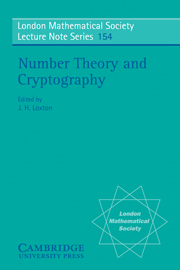Book contents
- Frontmatter
- Contents
- Contributors
- Introduction
- I NUMBER THEORETIC ASPECTS OF CRYPTOLOGY
- II CRYPTOGRAPHIC DEVICES AND APPLICATIONS
- 7 Security in telecommunication services over the next decade
- 8 Linear feedback shift registers and stream ciphers
- 9 Applying randomness tests to commercial level block ciphers
- 10 Pseudo-random sequence generators using structured noise
- 11 Privacy for MACNET
- 12 Authentication
- 13 Insecurity of the knapsack one-time pad
- 14 The tactical frequency management problem: heuristic search and simulated annealing
- 15 Reed-Solomon coding in the complex field
- PART III DIOPHANTINE ANALYSIS
11 - Privacy for MACNET
Published online by Cambridge University Press: 05 May 2013
- Frontmatter
- Contents
- Contributors
- Introduction
- I NUMBER THEORETIC ASPECTS OF CRYPTOLOGY
- II CRYPTOGRAPHIC DEVICES AND APPLICATIONS
- 7 Security in telecommunication services over the next decade
- 8 Linear feedback shift registers and stream ciphers
- 9 Applying randomness tests to commercial level block ciphers
- 10 Pseudo-random sequence generators using structured noise
- 11 Privacy for MACNET
- 12 Authentication
- 13 Insecurity of the knapsack one-time pad
- 14 The tactical frequency management problem: heuristic search and simulated annealing
- 15 Reed-Solomon coding in the complex field
- PART III DIOPHANTINE ANALYSIS
Summary
This paper examines the security of the MACNET shared fibre access network. The major threats to security are identified, and an encryption and key management scheme is proposed which is shown to bring the security to a similar level as that provided by dedicated fibre access. The robustness of the scheme to transmission errors, as well as the ease of implementation are also considered.
Introduction
The Customer Access Network (CAN) is that part of the telecommunications network located between the local exchange and the customer's premises. Traditionally, a star network architecture based on twisted copper pairs has been used; however, this is unable to meet the requirements of future broadband services. Due to the number of premises connected, the CAN represents a substantial proportion of the total capital investment in the Australian telecommunications network. To prevent the need for subsequent upgrading, it is desirable to ‘future-proof’ any alterations to the CAN by providing a transmission medium capable of meeting future needs.
Over the next few years, optical fibre will be progressively introduced into the CAN, providing broadband access to the customer. Current costs associated with optical equipment make the cost of a dedicated fibre CAN (ie a simple star architecture) prohibitive. One of the most promising schemes for early introduction of fibre to the CAN is the Multiple Access Customer Network (MACNET) [5,6,7].
- Type
- Chapter
- Information
- Number Theory and Cryptography , pp. 137 - 148Publisher: Cambridge University PressPrint publication year: 1990



